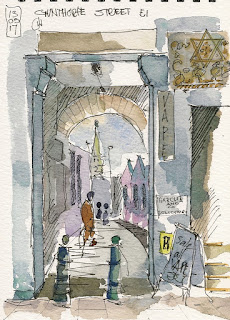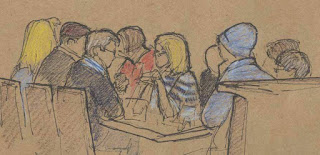Cute little road of Victorian terraced houses and atmospheric trees in the background. These sort of scenes just cry out for a bit of pencil; match made in heaven for me!
Tuesday, 30 May 2017
Brunel Road, Chigwell
Cute little road of Victorian terraced houses and atmospheric trees in the background. These sort of scenes just cry out for a bit of pencil; match made in heaven for me!
Sunday, 28 May 2017
Marble Hill House
I've sketched it a few times from different angles but today fancied getting up close for the gutsy angular perspective enhanced by my low sketcher's stool. Bit of a challenge.
Marble Hill House
Tuesday, 23 May 2017
We drew Sloane Square 20 May 2017
 |
| At the Venus Fountain in Sloane Square |
[By Evelyn Rowland in London] Lots of sketchbooks filled with lots of lovely stuff. As usual, nippy weather didn't put people off and we found loads of interesting features to have a go at. So, here's a few who were there at the beginning, and those who stayed to the end, which I think was everybody. Many thanks to Nicky and Jo for being there, and investigating draw-able places. On to the next one!
 |
We drew Sloane Square 20 May 2017
Friday, 19 May 2017
Gunthorpe Street, Whitechapel
Realising the Edwardo Paolozzi exhibition at The Whitechapel Gallery was ending, I hurried up there last Saturday and got the bonus of serendipity.
Having taken the wrong exit from Aldgate East, I glanced Christ Church Spitalfields through the archwayed entry to Gunthorpe Street and felt the sketcher’s urge. Originally George Yard, the street was one of many alleys along Whitechapel High Street, itself a revealing mix of signs, symbols, shops and solicitors' offices. Knowing nothing of its history, I dug about to find what I suspected. The joy of today’s sneak view masked an earthy past. Its claustrophobic mixture of lodging houses, stables and narrow courts gave it a mean reputation. In 1822 it was described as a "notorious rendezvous of thieves" and went on to be the scene of every conceivable crime, including inevitably a bit of Jack the Ripper’s work.
George Yard was renamed Gunthorpe Street in 1912, after John Gunthorpe who was rector of St Mary's Whitechapel in 1471.
Gunthorpe Street, Whitechapel
Sunday, 7 May 2017
Let’s draw the Charterhouse and Clerkenwell - Saturday 17 June 2017
We will visit two locations: Charterhouse Square and neighbouring Clerkenwell. In Charterhouse Square is the Charterhouse, an ancient former monastery and chapel, which has very recently been partly opened to the public, with a new museum. Clerkenwell is an interesting neighbourhood, with a mix of old and new buildings and a concentration of design professions. We will visit the St John’s Gate and museum, including its beautiful Cloister Garden.
The day is free of charge, no need to book, just turn up with your art kit.
This location replaces the visit to the Inns of Court proposed on our original 2017 programme.
Key times and meeting points for the day:
11am: Meet at Charterhouse Square, in front of the Charterhouse museum (see photograph above) or just inside the museum if wet.
1pm: Meet at the museum to look at drawings done so far.
3.30pm: Meet outside the Cloister Garden, St John’s Square, Clerkenwell, (see photograph below) or just inside the entrance if wet, to look at drawings done, and take group photographs.
Options for drawing include:
Charterhouse Square has recently been re-landscaped and opened to the public, and provides a quiet, leafy environment to draw the surrounding historic buildings
The Charterhouse and chapel (exteriors) founded in 1371
The Charterhouse museum and chapel interior (free admission)
St John’s Gate, Clerkenwell, a Tudor gatehouse which can be drawn from either side as traffic is not allowed to pass through.
Museum of the Order of St John (free admission)
The Cloister Garden which grows many of the medicinal plants which would have been in use at the priory.
Street scenes, shops, and cafes in Clerkenwell.
Background
The Charterhouse was founded in 1371 as a monastery for the Carthusian order. In the early seventeenth century it became the home of a charitable foundation, providing a school (now in Surrey) and a home for poor elderly men. It still provides sheltered housing for forty elderly ‘brothers’ (although they are not monks) in part of the building. A new museum has been developed in part of this historic building, and earlier this year the museum, chapel and part of the building were opened to the public for the first time. http://www.thecharterhouse.org/
Neighbouring Clerkenwell provides a mix of old and new. It is a short walk from Charterhouse Square to St John’s Gate, on St John’s Lane. This Tudor gatehouse houses the Museum of the Order of St John, showing something of the area’s history. This gatehouse and the remaining parts of the twelfth century church on the other side of Clerkenwell Road, are remnants of the Priory of the Knights of St John, which is the precursor of the St John’s Ambulance. During the reign of Queen Elizabeth I, the offices of the Master of the Revels were located in these buildings and Shakespeare visited to license many of his plays.
Clerkenwell has a complex history, and now has many fashionable shops, craft galleries, bars and restaurants, with interesting side streets and pedestrianised areas. The area has a concentration of design-focussed businesses.
Practical information
The nearest underground station is Barbican. Leaving the station, you are on Aldersgate Street. Turn left and soon turn left again, on to Carthusian Street, and you will see the trees of Charterhouse Square ahead of you. Once in Charterhouse Square, walk round the Square to the right and you will see the Charterhouse and museum. Thackeray’s Café is the museum café, and there are other cafes and shops near the underground station and in Clerkenwell.
In the afternoon, from Charterhouse Square, walk down Charterhouse Street to the back of Smithfield Market, turn right up St John Street, and fork left up St John’s Lane. You will see St John’s Gate ahead of you. The Cloister Garden is further up St John’s Lane, on the other side of Clerkenwell Road, in St John’s Square.
If wet, we can draw inside the Charterhouse Museum and chapel, and at the Museum of the Order of St John in Clerkenwell. There are toilets in both the museums.
The day is run by Jo Dungey and Gafung Wong
Let’s draw the Charterhouse and Clerkenwell - Saturday 17 June 2017
We drew Alexandra Palace 29 April 2017
[By Elizabeth Blunt in London] Despite the rather ho-hum weather, there was a good turnout for our trip to Alexandra Palace on April 29th, and sketchers found plenty to keep them busy in the eccentric charms of north London's People's Palace.
There was, of course, that view; Jo reckoned we could see every place where we had ever sketched. Helen Pavli caught it in moody monochrone.
The prize for close observation went to Philip Stones, who captured the radio waves radiating from the old BBC mast – 'The Archers', I think, or possibly 'From our own Correspondent'.
Meanwhile some participants, fresh from a 'Space Oddity' workshop in Barcelona, had fun trying out their perspective-warping skills on the Palace's imposing facade. (This was Elwyn Edwards' version.)
Ally Pally, of course has plenty of oddities of its own, from the Lohengrin-style swan boats on the lake to the pyramids, sphinxes and tropical greenery in the Palm Court. (Thank you Zane Karklina and Andy Lee.)
The day ended in the Phoenix Bar, so called because Ally Pally has twice burned down, and twice risen again from the ashes. (Seen here by Cal Hoy)
We drew Alexandra Palace 29 April 2017
Subscribe to:
Posts (Atom)

























